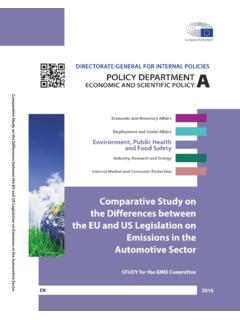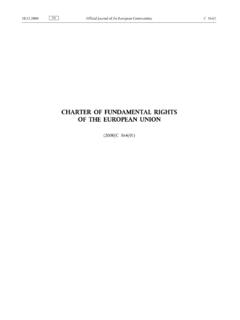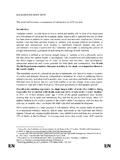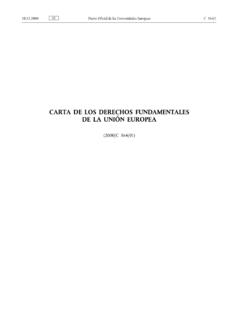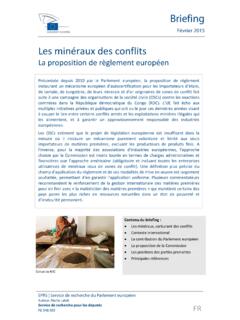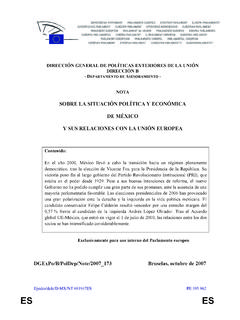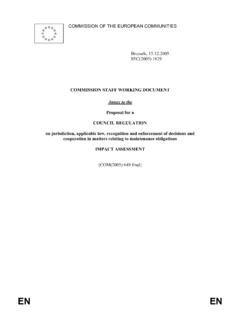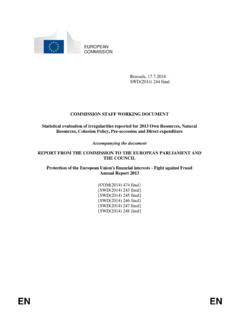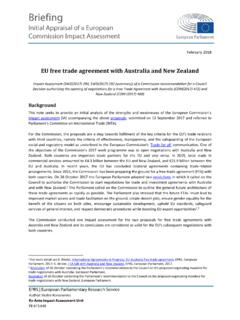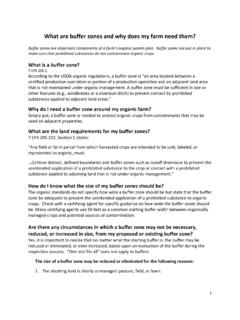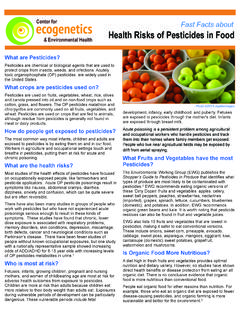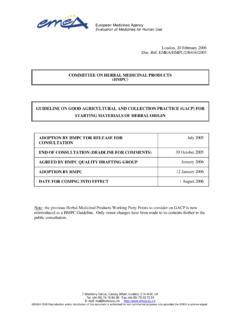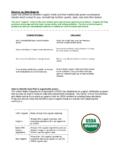Transcription of EU policy and legislation on pesticides
1 IN-DEPTH ANALYSISEPRS | European Parliamentary Research ServiceAuthor:Didier BourguignonMembers' Research ServiceApril2017 PE (or. FR)EU policy andlegislation onpesticidesPlant protection productsand biocidesThis publication presents an overview ofEuropean Union policy on pesticides . It describes the contextin which the policy was formed, presents both the negative and positive impacts of the products inquestion and reports on the debate surrounding this issue. It outlines European Union legislation onplant protection products and biocidal products, with particular focus on the approval process for activesubstances and product authorisation. The publication also gives an insight into the opportunities andchallenges associated with the legal framework. The views of stakeholders and the European Parliamentare also discussed. Lastly, it describes the measures that the European Commission is expected to takein the field in the years to manuscript, in French, completed in April completed in June CopyrightThis document is prepared for, and addressed to, the Members and staff of theEuropeanParliament as background material to assist them in their parliamentary work.
2 The content of thedocument is the sole responsibility of its author(s) and any opinions expressed herein should notbe taken to represent an official position of the and translation for non-commercial purposes are authorised, provided the sourceis acknowledged and the European Parliament is given prior notice and sent a copy. European Union, credits: oticki / policy and legislation on pesticidesPage1of31 EXECUTIVE SUMMARYS ubstances used to suppress, eradicate and prevent organisms that are consideredharmful aregrouped under the term pesticide . The term includes both plant protectionproducts (used on plants in agriculture, horticulture, parks and gardens) and biocidalproducts (used in other applications, for example, as a disinfectant or to protectmaterials).The use of pesticides offers numerous advantages; above all, biocidal products help tofight vector-borne or food-borne diseases, and plant protection products havecontributed to the leap in agricultural yield since the Second World War.
3 However, theuse of pesticides also brings a number of disadvantages, in particular, its impact on theenvironment (presence in the air, water or soil), risks to human health (for example, asa result of exposure to residues) and repercussions for crop protection. The use ofsynthetic plant protection products is fiercely debated in society, dividing supporters andcritics. In recent years the debate has crystallised around certain aspects, not least,identification criteria for endocrine disruptors, restrictions on someneonicotinoids andrenewed approval of the active substance Union (EU) legislation on pesticides is designed to ensure a high level ofprotection for human health and the environment and to improve the functioning of theinternalmarket. Plant production products and biocides are subject to a dual approvalprocess: active substances are approved at EU level and products are subsequentlyauthorised predominantly at Member State level.
4 The 2009 regulation on plantprotection productsand the 2012 regulation on biocidal products establish the approvalcriteria, the procedures (along with the timescales) and the derogations that may beapplied. Two European agencies are involved in the process: the European Food SafetyAuthority (EFSA)for plant protection products and the European Chemicals Agency(ECHA) for biocidal products. In addition, a regulation from 2005 sets the standardisedmaximum levels for residues of plant protection products in food, and a directive from2009 establishesa framework for action for sustainable pesticide aspects of EU policy on pesticides can be considered opportunities or challenges,for example, issues surrounding costs for the agrochemical sector (regulatory costs andcosts for research and development of new substances), approval procedures(evaluation and substitution of active substances, possible conflicts of interest,emergency authorisations and the cumulative effects of residues), sustainability(integrated pest management, recourse to biopesticides) and other related aspects(counterfeit pesticides and minor useof plant protection products).
5 The European Commission is assessing the legislation on plant protection products andtheir residues. The conclusions of that study are expected by the end of policy and legislation on pesticidesPage2of31 TABLE OF CONTENTS1. Pesticide Plant protection Biocidal Impact of Opposing European European The placing of products on the Approval of active Product Plant protection product Sustainable use of Other Opportunities and European Parliament Stakeholders' Main policy and legislation on pesticidesPage3of31 DefinitionsAcceptable daily intake:an estimated quantity of a substance, expressed in relation to bodyweight, thatcan be ingested through food every day over a lifetime without appreciable riskto the consumer (threshold for chronic toxicity).Active substance:in plant protection products and biocidal products, the active componentwhich counters harmful substances are approved at EU reference dose:an estimated quantity of a substance, expressed in relation to bodyweight, that can be ingested through food in one day without significant risk to the consumer(threshold for acute toxicity).
6 Adjuvant:a substance or preparation composed of co-formulants that is mixed with a plantprotection product to enhance its product:a product designed to combat organisms harmful to human or animalhealth and organisms that are detrimental to human activities. Such products includedisinfectants, material protection products, rodenticides, insecticides and repellents. Theyare authorised at Member State or European Union product family:a group of biocidal products with similar applications, the sameactive substances, a similar composition and similar risk and efficacy control agent:see (also known as a biological control product ): aproduct comprisedofsubstances that are derived from living organisms and certain Regulation:Regulation (EC) No1272/2008 on classification, labelling and packaging ofsubstances and :a substance or preparation used in a plant protection product or biocidalproduct which is neither an active substance, a safener, nor a assessment:an evaluation of risks and benefits managed by a Member Stateas part of the assessment process for a plant protection product or biocide in the context ofplanned substitutions of active :European Chemicals Agency.
7 ECHA is principally involved in approving the activesubstances in biocidalproducts and in some authorisation procedures for biocidal focus area:in the context of greening in the EU s Common Agricultural policy , anarea which supports biodiversity either directly or indirectly and represents at least 5%ofarable land in holdings larger than 15 :European Food Safety Authority. EFSA is principally involved in approving the activesubstances in plant protection phytosanitary practices(also known as good agricultural practices ): making use ofplant protection products in accordance with authorised conditions of use in a way thatensures optimal efficacy with the minimum quantity necessary; taking into considerationlocal conditions and the scope for using agricultural and biological organism:an undesirable organism that is detrimental to human activities. Harmfulorganisms include pathogens (bacteria, viruses, moulds and nematodes), invertebrates(mainly insects, acari and molluscs), a small number of vertebrates, and :the capacity of a substance, as a result of its inherent properties, to cause adverseeffects for humans and the pest management also known as integrated plant protection : the integratedintroduction of biological, biotechnological, chemical, physical or agricultural measuresEU policy and legislation on pesticidesPage4of31relating to a range of plants, strictly restricting the use of synthetic plant protection productsto the absolute minimum residue level (MRL):the maximum concentration of pesticide residue authorisedin food, set, in order to protect vulnerable consumers, on the basis of good food practicesand the lowest possible use(in the context of the regulation of plant protection products).
8 The use of a plantprotection product either against harmful organisms or on crops that are limited in numberin a Member State. Plant protection product authorisation granted for use on some selectedcrops may be extended to minor use for another crop under certain recognition:for specific cases, the scope for a Member State to recognise theauthorisation granted in another Member State for a plant protection product or :non-governmental trade:the option of using a simplified procedure to place on the market plantprotection or biocidal products whose composition is identical to a product that is alreadyauthorised in another Member :a substance that suppresses or eradicates a harmful organism, or prevents itsactivity. The term includes both plant protection products and biocidal products (although incurrent usage it is often used synonymously with plant protection products).Plant protection product:a product composed of active substances that protects vegetationfrom harmful organisms or prevents their activity.
9 Such products are mainly used inagriculture, but also in horticulture, silviculture and in green spaces and gardens. They areauthorised at Member State :a solution or mixture comprised of two or more Member State:The Member State overseeing the assessment of an activesubstance, a safener or a :the likelihood of adverse effects occurring when humans or the environment areexposed to a hazard. In other words, risk = hazard x :a substance or preparation added to a plant protection product to suppress orreduce its effects on some cultivation techniques(no-till farming): in agriculture, practices that limitploughing and therefore turning over the :a chemical element either naturally occurring or industrially of concern:a substance which has an inherent capacity to cause an adverse effecton humans, animals or the :a substance or preparation that enhances the activity of the active substance orsubstances in a plant protection article(in the context of regulation of biocidal products): an article, a substance or amixture that has been treated with biocidal products or contains biocidal policy and legislation on used to suppress, eradicate and prevent organisms that are consideredharmful are grouped under theterm pesticide.
10 That term includes both plant protectionproducts and biocidal products (see below). pesticides can be grouped not only by typeof use but also in different categories according to other important criteria, such as theirtarget, the origin of their active substances or their hazard category. Within the principalsynthetic pesticide categories that target specific harmful organisms (insecticides,fungicides and herbicides ), the modes of action against harmful organisms are set out,as are the different generations of 1 Classification of pesticides according to a number of criteriaSource:C. Regnault-Roger, Produits de protection des plantes: Innovation et s curit pour une agriculture durable,Lavoisier, Paris, 2014;Compendium of pesticides Common Names; World Health Organization,The WHOrecommended classificationof pesticides by hazard and guidelines to classification: 2009, estimated 67000 pest species are harmful to plants (of which 50000 are pathogens,9000 insects and acari, and 8000 weeds).
